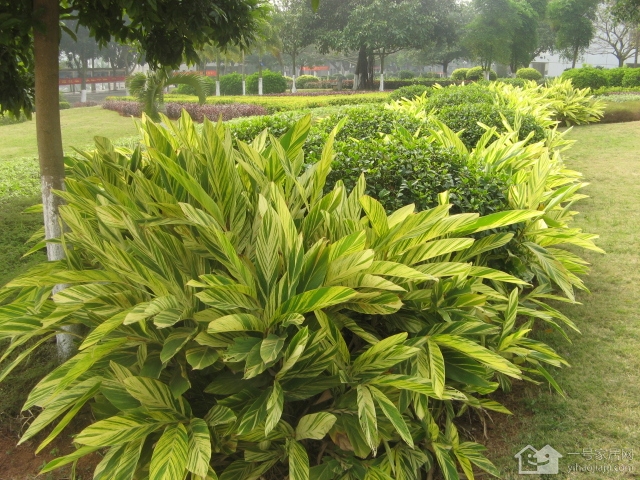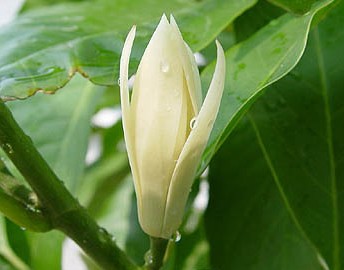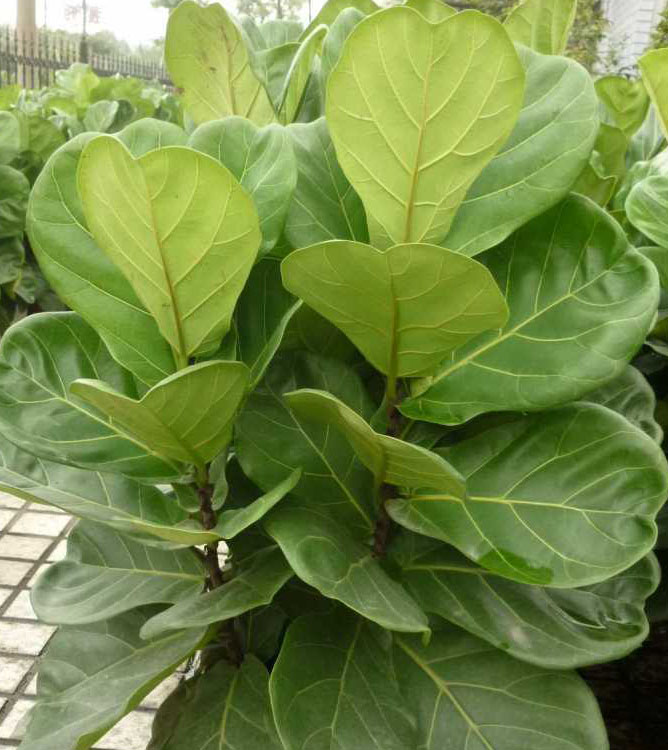What are the common diseases of alpinia officinalis?
Alpinia officinalis is often harmed by leaf blight and brown spot. At the beginning of the onset of leaf blight, 200-fold Bordeaux solution was sprayed every 7-10 days for 3 times. The occurrence of brown spot disease can be sprayed with 1000 times of thiophanate methyl.

Introduction of alpinia angustifolia
Shape: alpinia angustifolia Latin name is Alpinia zerumbet, alias alpinia officinalis, variegated leaf peach, colored leaf ginger, spotted moon peach, etc., about 1 meter high, dark green leathery leaf long oval-shaped lanceolate, 50-60 cm long, 10-15 cm wide, with irregular golden longitudinal stripes, bright color, such as proper maintenance, golden stripes connected into large pieces, is even more dazzling. It blossoms from June to July, the flower posture is elegant, the flower fragrance is attractive, the panicle is raceme, drooping.
Function: potted alpinia angustifolia is suitable for hall decoration, outdoor cultivation embellishes the courtyard, pool or corner, with a unique style. The ornamental effect of alpinia officinarum is very good on the side of the landscape, the edge of the green space and the courtyard.
Culture method of alpinia officinalis
Habits: like high temperature, humid environment, not resistant to cold, afraid of frost and snow. Like the sun, but also a little shady. Grow well in fertile loam.
Soil: when cultivating alpinia officinalis, we should choose loose soil with good drainage.
Reproduction: commonly used ramet and sowing reproduction. Ramets are propagated in spring and summer and plants with underground roots are dug up to cut off the aboveground stems and leaves. Keep 1/3 of the stem length, cut the rhizome 4-5 cm, each section with 2-3 stems, directly potted or planted in the open field. After planting, it was temporarily placed in a semi-shady place for maintenance, and the normal management was restored after the germination of new buds. The temperature of sowing and reproduction is 25-30 degrees Celsius and germinates 15-20 days after sowing.
Temperature: the optimum growth temperature of alpinia angustifolia is 18 ℃-30 ℃. Avoid cold frost. The overwintering temperature needs to be kept above 10 ℃. In winter, the temperature drops below 4 ℃ and goes into dormancy. If the ambient temperature is close to 0 ℃, it will die of frostbite.
Lighting: alpinia angustifolia is afraid of strong light, so it needs to be preserved in semi-shade, or give it 70% shade. If it is too shady, the leaves will not be bright enough. For indoor maintenance, put it in a brightly lit place as far as possible, and move to outdoor semi-shade or shade for a month every one or two months to accumulate nutrients and restore growth. If you put alpinia officinalis in a semi-shady place in midsummer, the leaf markings will be more obvious.
Moisture: alpinia officinalis likes a humid climate, requiring the relative air temperature of the growing environment to be 60-75%. When breeding, we should pay attention to keep the soil moist and avoid being too dry. In summer and autumn, we should often spray water on the leaves of alpinia officinalis to increase air humidity; in winter, alpinia officinalis is dormant, so we should water less and follow the principle of dry rather than wet.
Fertilization: alpinia angustifolia requires more fertilizer and water, but is most afraid of random fertilization, concentrated fertilizer and partial application of nitrogen, phosphorus and potassium fertilizer. It is required to follow the fertilization principle of "frequent application of light fertilizer, less amount and more times, and complete nutrition". Fertilizing once a month during the growing period, mainly phosphorus and potassium fertilizer.
Pruning: open-field cultivation needs to often remove dense stems and leaves and cut off broken stems and leaves to keep the plant shape beautiful. After 4 years of cultivation, the underground rhizome should be dug up again, the old rhizome should be removed, and the plant should be renewed.
Change the pot: due to the strong tillering ability and rapid growth of alpinia officinalis, the pot is changed every 1-2 years, the leaves are dull and too high, and the stems and leaves are replanted.
Diseases and insect pests: the main diseases are leaf blight and brown spot, so we should pay attention to timely treatment. At the initial stage of the onset of leaf spot, Bordeaux solution was sprayed 2-3 times every 10 days, and brown spot occurred. 70% methyl topiramate wettable powder 1000 times solution could be used to control the disease.
The above is the relevant introduction of this article, I believe you have a simple understanding of this after reading it, if necessary, you can continue to pay attention to the No. 1 home network for more information.
How to raise alpinia officinalis, the culture methods and matters needing attention of alpinia officinalis
Alpinia officinarum is a perennial herb with colorful leaves. June-July is the flowering period, the posture is elegant, the flower smell is fresh and pleasant, and the family pot culture should be placed in the hall or decorated in the courtyard. In this paper, the cultivation methods and points for attention of alpinia officinalis are shared with you.
Culture method of alpinia officinalis
Huaye Yanshan ginger likes the growth environment of high temperature and high humidity, which can withstand the semi-overcast environment, and the most suitable growth temperature is 15-30 degrees. It is suitable to be planted in fertile, loose and breathable soil. It is native to tropical Asia.
The propagation of alpinia angustifolia is mostly carried out in spring and summer, the underground rhizome is dug out, and the aboveground part is cut off and planted separately. The newly transplanted plants should be placed in semi-shade for maintenance, and then moved to the bright place for normal management after the plant sprouts.
Alpinia angustifolia is fertilized once a month in the vigorous growth period, mainly phosphorus and potassium fertilizer, so that the basin soil is consistent, the hot summer season should often spray water to the leaves to cool, and moved to the semi-shade outside maintenance, so as not to burn the leaves and affect the ornamental.
The cultivation of alpinia officinalis is easy, it needs more sunshine in late spring and early summer, and reasonable light can make the leaf pattern bright. Alpinia angustifolia is not cold-resistant. When the temperature drops to 10 degrees, the plant should be wrapped in paper to avoid frostbite. Potted alpinia officinalis should be moved indoors, as long as the temperature is not too low, it can pass the winter safely.
Matters needing attention of alpinia officinalis
If alpinia officinalis is not managed properly, it is prone to some diseases, such as leaf blight and brown spot, which should be prevented as soon as possible. 200 times Bordeaux solution can be sprayed every other week at the initial stage of the disease, and it can be effective two or three times. Brown spot disease can be controlled by spraying 1000 times of thiophanate methyl.
The leaves of alpinia angustifolia are one of the snails' favorite foods. at ordinary times, we should pay attention to the prevention and control of snails, which can be caught manually or sprayed with 1000 times of dichlorvos.
Alpinia officinalis is a typical foliage plant with gorgeous colors, which can be used for subjective flowers or garden ornaments. These are the breeding methods and matters needing attention of alpinia officinarum. For more information on flower culture, please pay attention to the encyclopedia of China Agricultural Chemical Merchants Network.
- Prev

White orchids suffer from yellowing disease how should do?
White orchids like acid soil, its chlorosis is caused by alkaline soil or alkaline irrigation water. Symptoms are yellow leaves, black roots and rot. The control method is to spray wine leaves with 0.2% ferrous sulfate aqueous solution. Spray every 5~7 days, and often apply 0.5% ferrous sulfate aqueous solution
- Next

How should Qin leaf banyan get leaf spot disease?
Short-term temperature fluctuations and too much water in the dormant period will cause leaf spot disease, and the diseased leaves should be removed in serious cases. Control methods: timely removal of diseased tissue, centralized burning; rotation, indoor soil change; not suitable for plant spraying; spraying from the early stage of the disease to prevent the spread of the disease.
Related
- Fuxing push coffee new agricultural production and marketing class: lack of small-scale processing plants
- Jujube rice field leisure farm deep ploughing Yilan for five years to create a space for organic food and play
- Nongyu Farm-A trial of organic papaya for brave women with advanced technology
- Four points for attention in the prevention and control of diseases and insect pests of edible fungi
- How to add nutrient solution to Edible Fungi
- Is there any good way to control edible fungus mites?
- Open Inoculation Technology of Edible Fungi
- Is there any clever way to use fertilizer for edible fungus in winter?
- What agents are used to kill the pathogens of edible fungi in the mushroom shed?
- Rapid drying of Edible Fungi

